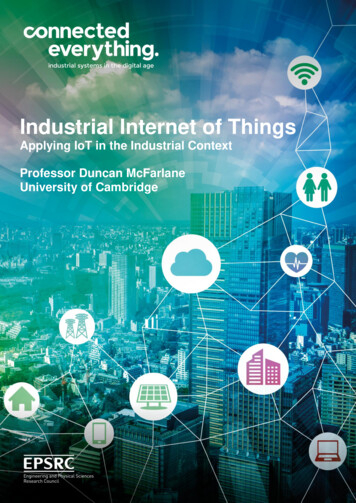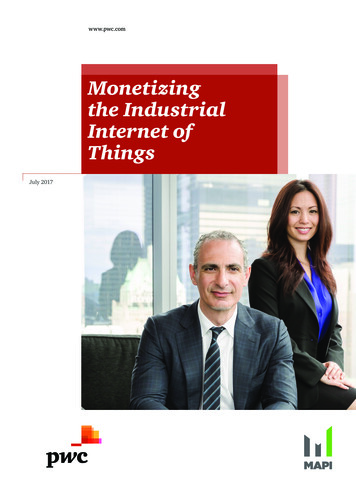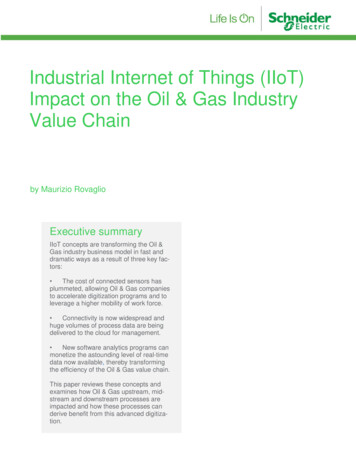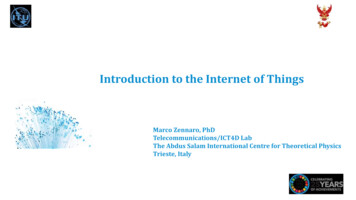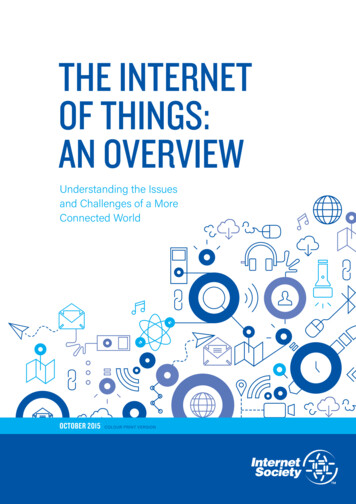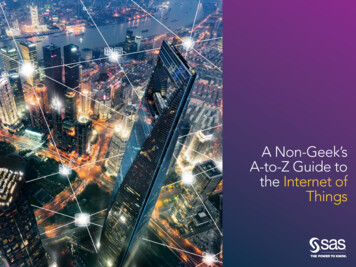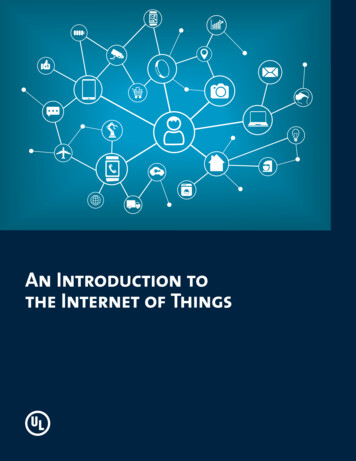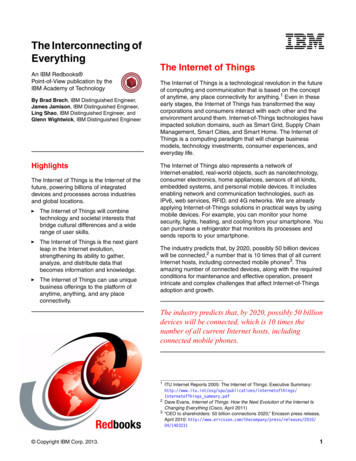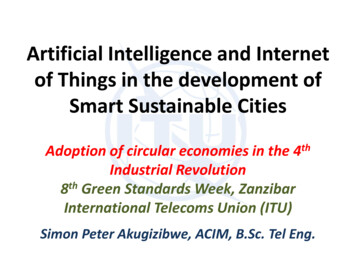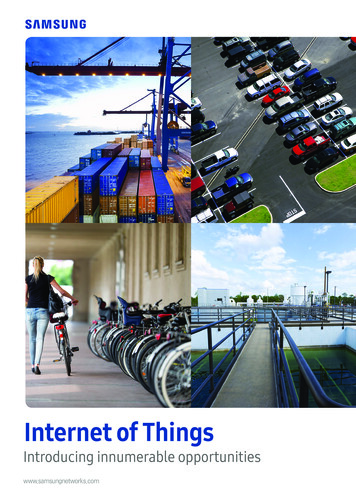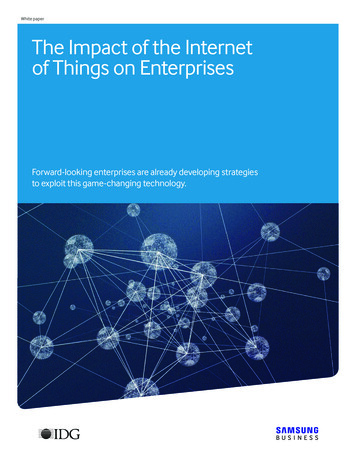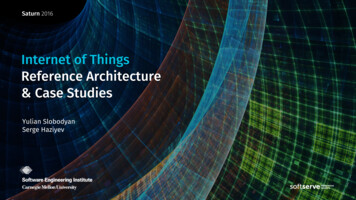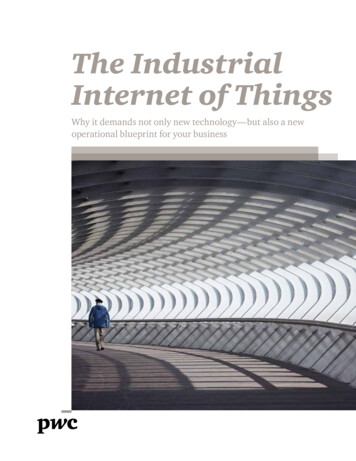
Transcription
The IndustrialInternet of ThingsWhy it demands not only new technology—but also a newoperational blueprint for your business
ii
At a glanceAcross the world, forward-thinking manufacturersand industrial product companies have made greatstrides in connecting their products and appliancesto the Industrial Internet of Things (IIoT). Butsucceeding in the IIoT era demands much morethan technology connectivity. In fact, the adventof the IIoT is a once-in-a-lifetime businessdisruption—one that requires new capabilitiesin managing direct relationships with customers,supported by transformed operating and businessmodels designed specifically for an IIoT-enabledworld. And it’s a disruption that’s coming faster thanmost companies think. Those manufacturers thatmove to tackle the necessary transformation todaywill position themselves as future leaders in theirmarkets. Those that fail to act now risk being leftbehind—and will face a real struggle to catch up.The Industrial Internet of Things1
Chapter header 6 trillion will be spent onIoT solutions between 2015and 2020 (compounded).Business investment willgrow from 215 billionto 832 billion versusconsumers at 72 billionin 2015 to 236 billionin 2020.2
Combined, businesses,governments andconsumers will investnearly 1.6 trillionto install IoT solutionsin 2020.Software and applicationdevelopment are predictedto make up the majorityof the investment.Source: BI Intelligence, THE INTERNET OF THINGS 2015: Examining How The IoT Will Affect The World, November 2015The Industrial Internet of Things3
Realising the opportunityof the IIoT Picture the scene: You’re the CEO of a companythat manufactures Heating, Ventilation and AirConditioning (HVAC) units for consumers. You’veseen and embraced the emergence of the IIoT, andhave invested accordingly in establishing Internetconnectivity for the HVAC systems you sell.As a result, you can monitor and maintain yourHVAC system’s performance remotely in people’shomes, detect imminent leaks or failures, andalert your customers to possible problems. Butyour customers’ satisfaction with your offeringsseems to be falling rather than rising. Why?The answer lies in the changing expectations anddemands of today’s connected consumers—but also in the pervasive impacts of the IIoT onyour operations and business model. Put simply,connecting appliances and devices to the Internetis perhaps the easiest part of the challenge ofdealing with the IIoT disruption. Alongside thetechnology, it’s every bit as important to addressthe behavioural, operational and business modelimpacts it brings with it.4On the customer front, there’s a growing trendfor consumers—and also business customers—to want direct links to the companies thatmanufacture the products and services they use,cutting out the traditional ‘middlemen’. Thisprofound behavioural shift is evident across ahost of industries, from energy to telecoms,and from mainstream media to technology.It’s one of the key drivers of manufacturers’industry-wide move into services—a changethat increasingly involves progressing fromproduct-based to service-based offerings bybuilding platforms, thus simultaneouslyexpanding revenues and building ‘stickiness’(see Figure 1).Meanwhile, on the operational front, the fact isthat Internet connectivity—for a HVAC systemor any other piece of equipment, whether a brakepad or a turbine engine—means much more thanjust linking it digitally to your business’ systems.It also represents a way of getting closer to endusers than ever before, creating a degree of directcustomer engagement and interaction that mostmanufacturing companies have never experienced.
On the customer front, there’s a growing trend forconsumers—and also business customers—to wantdirect links to the companies that manufacture theproducts and services they use, cutting out thetraditional ‘middlemen’.Platform-as-a-ServiceProduct Value-add ServiceCustomer EngagementRevenue ExpansionFigure 1: Companies moving from product-based offerings to service-based offerings by building platforms,expanding revenues and building stickinessProduct Remote SupportStand-aloneProductIoT Services RoadmapSource: PwCThe Industrial Internet of Things5
demands capabilities thatare new to manufacturingThis is a profound step-change with implicationscompanies underestimate at their peril. Historically,a traditional manufacturing business sellingthrough distributors and/or retailers wouldprobably not even have run an end-customerhelpline. But to keep its customers happy and loyalin the IIoT world, it needs to build a sophisticatedand responsive customer management and serviceacumen capability.To see why, imagine a situation in which themanufacturer’s predictive analytic systemstrigger a warning-light on a household’sIIoT-connected HVAC system, signalling thatit’s about to break down. Inevitably, the customer’sresponse will be: “Fine, you’ve warned meproactively. But what do I need to do now?” If theproblem can be fixed remotely, the answer may be“nothing at all”. But unless the manufacturer canmanage, engage and reassure the customer, theeffect of IIoT connectivity may well be to damagethe relationship rather than strengthen it. Perhapsthe service manager places a call to the customerscheduling a preventative maintenance visit.Moreover, when the field technician does showup to the site, he has the right parts to replaceand is also armed with what may go wrong inthe near future.Figure 2: The need for a robust ‘operations’ architecture alongside the ‘data delivery’ nsSupportSystemsOperations ArchitectureEquipmentSource: eData Delivery ArchitectureAppsData
So, while all current IoT implementations focuson the ‘data delivery’ architecture, a robust‘operations’ architecture is also needed in orderto maximise customer engagement (see Figure 2).Our experience suggests that many companieshave yet to think these implications through.Commendably, they’ve responded to the rise ofthe IIoT by getting their appliances online andconnecting them to their central manufacturingdatabase and core systems. But in focusing on theshiny new IT aspects, they’ve often overlooked theneed for new operational capabilities demandedby the new communication return path fromthe customer.This challenge underlines the double-edgednature of IIoT connectivity. True, it opens upopportunities to expand customer revenuesby selling value-added services like remotemonitoring, maintenance, and other value-addservices such as insurance. All of these offeringsare made more viable—and potentially moreprofitable—by the granular, real-time devicedata made available thanks to IIoT sensors andconnectivity. But failing to invest simultaneouslyin operational and customer care capabilities willdrastically undermine these benefits.Industrial IoT versusconsumer IoT: Severalmagnitudes of differenceIn the mainstream media, theexplosive growth of the IoT is mostoften discussed mainly in terms ofconsumer devices and products.But if you consider the scale of theindustrial products sector and itspotential for device connectivitythroughout the supply chain andwith customers, then it’s set todwarf the size of the consumerIoT by several magnitudes. Whilea few billion consumer devices—wearables, home automationdevices, cars—will become IoTconnected during the next fiveyears, the equivalent global growthcurve for the industrial IoT is set torocket towards 100 billion devices asthe technology becomes pervasive inindustrial sectors worldwide.The Industrial Internet of Things7
8
Manufacturing and industrialcompanies must re-engineertheir strategy and culture However, to realise the full opportunities presentedby the IIoT, more is required than just hiringa roomful of service reps. To truly leverage itsnew direct customer relationship and make thefull transition to an IIoT-enabled, customercentric and service-orientated organisation,a manufacturing business must fundamentallytransform its strategy and organisational culture.So while the operational challenges aresignificant, it’s important for companies tograsp the fact that those challenges can onlybe discussed and understood in the context ofa holistic and strategic review of the company’sbusiness models, new forms of customerengagement, and other related issues. In otherwords, the operational challenges result fromthe transformation that will become evidentonce a holistic and strategic review is done.Furthermore, to achieve the required degreeof customer centricity, the organisation willneed to move away from a historical focus onengineering and products, and towards a mindsetthat puts customers front and centre. A culturechange as profound as this is a major undertakingfor any business. It’s especially challenging for amanufacturing company with a deeply-embeddedengineering culture. However, it’s a transformationthat’s becoming increasingly imperative, forseveral reasons.One is that manufacturing and industrial productsbusinesses are among the organisations thatwill be impacted most directly and deeply bythe widespread disruption springing from IIoT.Not only do their products, markets and processeshave a high propensity for IIoT-driven change,but also these companies have among the largestnumbers of devices and appliances that will needto be adapted for IIoT connectivity. In this context,it’s interesting to compare the projected size ofthe Industrial IoT with that of the Consumer IoT—a point examined in the accompanying informationpanel on the previous page.A second reason for the scope of change requiredby the IIoT lies in manufacturing and industrialcompanies’ legacy plants and processes. In manycases these have remained little altered for decades.But they’re now set to change dramatically, asIIoT connectivity drives rapid convergencebetween operational technology (OT)—robots,conveyor belts, smart metres, generators, substationequipment, transformers and the like—andinformation technology (IT) such as back-officesystems and software.The Industrial Internet of Things9
and adopt a radicallydifferent product designphilosophyAs well as requiring complex systems integration,this convergence will compel companies to thinkvery differently about their supply chains andmanufacturing methods—and to revisit theirentire approach to product design and development.To return to the example of the consumer HVACsystem, designing and building an HVAC systemor other appliance from ground-up to be connectedto the IIoT is very different from taking a legacydesign and ‘bolting on’ an Internet connection.This new design philosophy raises furthercomplexities. An appliance designed to makethe most of the IIoT will require differentcomponents and therefore a new supply chain.What’s more, it’ll need to have robust cybersecurity built in—an imperative that has beenunderlined in recent years by the high-profileinstances of criminals gaining access to the coreIT systems of major corporations by hacking invia their commercial heating and cooling systems.A few years ago, these appliances didn’t evenneed to have physical locks; now they representa potential Achilles’ heel that can expose a businessto a major breach.10This new designphilosophy raisesfurther complexities.An appliance designedto make the most ofthe IIoT will requiredifferent componentsand therefore a newsupply chain.
An ‘Operations Checklist’ for seizing the IIoT opportunityPConduct a holistic and strategicreview of business models, new formsof customer engagement, and so on.PLock the increased customer centricityin place by embedding culture changeat all levels across the business.PMaintain the momentum of imple-menting IIoT connectivity for devices,sensors and networks.PPDiscuss and understand the degreeof operational change required,and the challenges it involves.Continue to review and innovatearound operations and technologyon an ongoing basis, to keep drivingfurther business benefit from IIoT.PCombine technology and operational change to transform theorganisation’s customer centricityand put the customer front and centre.The Industrial Internet of Things11
IIoT-driven transformationis not just imperative—but urgent As industrial companies take these implicationson board and develop their IIoT strategies andapproaches, a question that commonly arises ishow fast they need to move. How long is theirwindow of opportunity? Do they have five yearsto transform to a new technology and operatingblueprint for the IIoT world? Two years? Justsix months? The answer may vary by industry.But in virtually every case, we think the availabletimeframe for IIoT transformation is shorter thancompanies currently believe. Similar to otherindustries, the Internet will accelerate disruption.Why? Because the stars are now aligned in a waythat will see the IIoT advance and expand far morequickly than many businesses expect. The paceof growth is underlined by research from Gartner,who predicts that spending on new IoT hardwarewill exceed 2.5 million a minute in 2016—and that, by 2021, one million IoT devices willbe purchased and installed every single hour.1Gartner also forecasts that the number of thingsconnected to the Internet will grow to 35 billionby 2020, and that 47% of these devices will havethe necessary intelligence to request support.2This opportunity could usher in new playersand threaten the status quo.1 Gartner, “Top Strategic Predictions for 2016 and Beyond:The Future Is a Digital Thing”, 2 October 2015.2 Gartner, “Forecast: Internet of Things, Endpoints andAssociated Services, Worldwide, 2014”.12The headlong growth in the IIoT reflects severaldrivers. First, the costs of IT are plummeting acrossthe three key domains of storage, compute powerand network capacity, even as the number of devicesthat can potentially be connected continues toproliferate. Second, the continuing floodof start-ups
the Industrial IoT with that of the Consumer IoT— a point examined in the accompanying information panel on the previous page. A second reason for the scope of change required by the IIoT lies in manufacturing and industrial companies’ legacy plants and processes. In many cases these have remained little altered for decades. But they’re now set to change dramatically, as IIoT .
